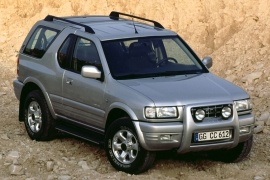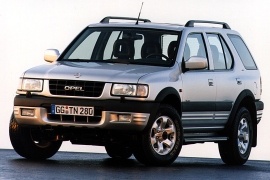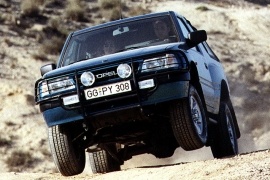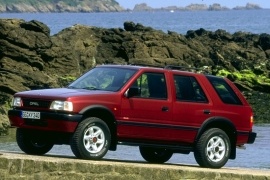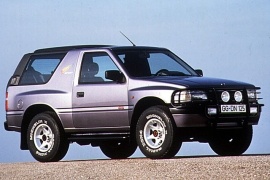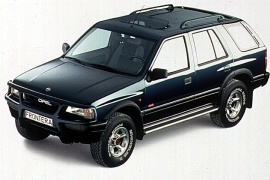OPEL Frontera Models/Series Timeline, Specifications & Photos
First production year: 1992
Engines: Gasoline, Diesel
Body style: SUV (Sports Utility Vehicle)
Opel introduced the second generation of the Frontera SUV in 1998, and even if it didn't look that much different than its predecessor, it was actually a new vehicle.
The German automaker was new in the SUV segment, but its parent company, GM, was not. So, the American company decided to join forces with Honda and Isuzu and introduced the first generation of the Frontera. It was a mild success, but it was good enough to convince them to create a second generation, where they fixed most of the problems seen on the Frontera I.
At first glance, it was the same vehicle as before. Yet, the automaker's designers reshaped the bodywork and gave it a smoother look, with rounded corners. At the front, the rectangular headlights were continued on the sides by the corner-mounted blinkers. In addition, the plastic bumper was redesigned to look more aerodynamic and incorporate a wide center air intake. The three-door version, named Frontera Sport, featured a small triangular window between the doors and the tilted-forward C-pillar.
Inside, the automaker struggled harder to create a friendlier, better-equipped cabin. Gone were the straight angles and corners from its predecessor. On the 1998 Frontera, the curved lines looked like they were drawn for a sedan. Yet, between the front seats, the two sticks for the gearbox and the transfer case reminded customers that this was an actual SUV, built to tackle more than a curb and a sidewalk during a parking maneuver.
Under the smoothed bodywork, Opel installed a chassis with front independent suspension and a live axle in the back. In addition, the carmaker offered the Frontera with a choice of three engines: one turbo-diesel and two with gasoline. Besides the five-speed manual, Opel offered a four-speed automatic as an option for selected versions.
In 1998 Opel introduced the second generation of its Frontera SUV with a choice of two bodyworks: sports with three doors and Wagon with five doors.
Despite looking very similar to its predecessor, it was actually a completely new vehicle. It was the German brand version of the Honda Passport or Isuzu Rodeo, albeit the European model was slightly different in terms of engine lineup and options. Moreover, this second generation tried to prove that GM could offer a trustworthy SUV for the Old Continent.
At first glance, it was the same vehicle as before. Yet, the automaker's designers reshaped the bodywork and gave it a smoother look with rounded corners. At the front, the rectangular headlights were continued on the sides by the corner-mounted blinkers. In addition, the plastic bumper was redesigned to look more aerodynamic and incorporate a wide center air intake. The rear doors featured rounded corners, following the bio-design trend that conquered the automotive design studios at that time.
Inside, the automaker struggled harder to create a friendlier, better-equipped cabin. Gone were the straight angles and corners from its predecessor. On the 1998 Frontera, the curved lines looked like they were drawn for a sedan. Yet, between the front seats, the two sticks for the gearbox and the transfer case reminded customers that this was an actual SUV, built to tackle more than a curb and a sidewalk during a parking maneuver. The rear seats were quite roomy for adult-sized passengers, and the flat-folding bench could expand the trunk area almost to an LCV standard.
Under the smoothed bodywork, Opel installed a chassis with front independent suspension and a live axle in the back. In addition, the carmaker offered the Frontera with a choice of three engines: one turbo-diesel and two with gasoline. Besides the five-speed manual, Opel offered a four-speed automatic as an option for selected versions.
Born as a joint project between General Motors, Isuzu, and Honda, the Opel Frontera was the European version of the family, and it was a bold statement.
When Opel introduced the car in 1989, it was the beginning of the SUV era, and there were just a few carmakers that offered something similar on the market, and most of them were expensive. Take, for instance, Nissan's Pathfinder or Toyota's 4Runner. They were great and well-known. But in Europe, Opel was a newcomer, despite having a solid background with common ties with GM and Isuzu.
In 1995, the carmaker decided to introduce a facelifted version, which came with a wide range of improvements in all areas. The three-door vehicle sported the same rectangular headlights with rounded edges as its American cousins. Yet, there were a few differences, such as the front fascia that received softer lines. After all, it wasn't a truly capable off-road vehicle. In addition, the C-pillar was racked-forward on the sides and formed a triangular-shaped small window behind the B-pillar. In the back, the car featured a removable hard-top or a canvas.
Inside, Frontera Sport featured a narrow dashboard with a curved fascia to look a little bit more stylish. The carmaker installed the HVAC controls up on the center stack. In contrast, the center console was occupied by the handbrake, the gear stick, and the transfer box selector. It offered a decent room in the front but with limited legroom in the rear.
On the European market, the Frontera took its main engines from Isuzu (2.3 turbodiesel version) and Honda (3.2-liter V6). However, it was also available with GM's 2.0-liter inline-four already sold on the Old Continent for other Opel vehicles.
The European arm of GM, Opel, introduced the facelifted version of the Frontera SUV in 1995, fixing most of the problems encountered by the model when it was launched in 1989.
The Frontera was a product developed by GM in cooperation with Honda and Isuzu and was available in several markets from the U.S. to Australia and from Northern Europe to Africa. Moreover, it sported several badges on the grille, such as Holden, Opel, Honda, Isuzu, Vauxhall, and Chevrolet.
One of the biggest complaints about the car was about the lights department, and GM improved the headlights and also changed their styling in the process by rounding them a bit more at the corners. Moreover, the clear-lense blinkers and parking lights mounted vertically on the corners were seamlessly continued by the flared wheel arches. The bumper was no longer completely black but sported an unpainted upper section that could protect better against scratches. On the side, a black rubber stripe crossed the doors and proved to be effective in protecting the bodywork against shopping carts. Despite having more room in the trunk than its three-door sibling, the Frontera kept the full-size spare wheel on the tailgate, giving the vehicle a stronger appearance.
Inside, the restyled dashboard featured rounded edges and a small instrument cluster flanked by several buttons mounted on its frame. Yet, the rectangular vents remained in place, and the stereo took the lowest position on the center stack. Between the front bucket seats on the center console, the carmaker installed the gearstick and the low-range transmission lever.
Under the hood, Opel installed a new engine range. The 2.0-liter powerplant was replaced by a stronger and more economical 2.2-liter, fuel-injected unit. For the turbo-diesel versions, the 2.3-liter was replaced by a 2.4-liter and a 2.8-liter, respectively.
Without any experience in the SUV category, Opel took for granted what GM said and produced the Frontera for the European market.
At the beginning of the '90s, the SUV segment was small in Europe. Apart from Mercedes-Benz, Land Rover, and the Japanese trio (Toyota, Mitsubishi, and Nissan), there were no other real contenders in this segment since Suzuki and Daihatsu had smaller vehicles. Yet, with help from its parent company GM, Opel introduced the Frontera in 1993 with two or four doors and a tailgate.
The Frontera Sport was the three-door version of the multinational SUV, and it looked like it was ready to conquer the world. Thanks to its short wheelbase and overall length the Frontera Sport handled well in cities. The flared wheel-arches and the squared-looking body, although with some rounded lines here and there, made it attractive. Behind the doors, a raked-forward B-pillar also served as a safety arch in case of a roll-over situation. At the back, the removable top transformed it into a convertible and a fun car for younger generations.
Inside, the squared-looking dashboard sported a rectangular instrument cluster with a few buttons on the rim. The center stack hosted the ventilation controls on the upper side and the tape-player on the lower side. If the front passengers could sit relaxed on their bucket seats, in the back, the legroom was limited.
Despite the "Sport" name, there was nothing sporty on the car. Under the hood, Opel installed its own 20NE (2.0-liter naturally aspirated) gasoline engine that produced just a mere 114 hp (116 PS0). It was mated to a five-speed manual and a high and low transfer case.
General Motors, Isuzu, and Honda joined forces and developed an SUV sold under different badges across the world. In Europe, that SUV was known as the Opel Frontera.
Since GM had some shares in Isuzu’s stakes, it was considered good to develop an SUV together. It also asked Honda, who tried to expand its portfolio in the U.S., to join the club and bring its V6 gasoline engine. For the European market, instead, GM prepared only GM-sourced and Isuzu turbodiesel powerplants.
As part of General Motors, Opel was entrusted with the sales of the three- and five-door version of the newly developed SUV and launched it on the market under the Frontera nameplate. The longer version benefited showed a squared-looking body. Its rectangular headlights, flared wheel arches, and raked-forward C-pillars made the car look modern for those times when most off-road vehicles featured flat straight tailgates.
Inside, the squared lines continued and matched the exterior design. Thanks to the longer wheelbase than for the three-door version, the Frontera Wagon provided two seats at the front and a folding bench in the rear. Opel installed a similar dashboard with its siblings sold under Honda, Chevrolet, or Isuzu badges. The squared instrument cluster was narrow, just enough to cover the dials and host a few buttons on its sides. On the center console, the carmaker installed the gear stick and the lever for the high and low transfer box.
Under the hood, Opel installed its inline-four gasoline engines and a turbodiesel developed by Isuzu. The front independent suspension and the rigid rear axle made it a good all-around vehicle, comfortable enough on the streets but not afraid to tackle some muddy roads or trials.
